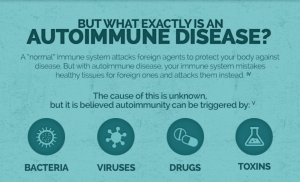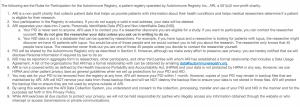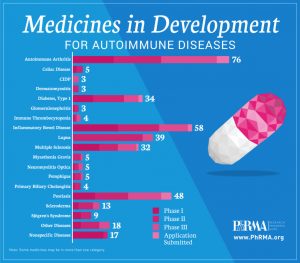A New Development in Autoimmune Disease Research
By Anonymous | October 8, 2021

Autoimmune diseases are a class of diseases that have perplexed researchers and medical experts for decades. Autoimmune diseases affect over 15 million people in the United States and are prevalent among women between 20-40 years old [1]. With over 150 diseases and 40 subtypes that are characterized by a wide range of symptoms, it is often difficult to recognize that a patient has an autoimmune disease or diagnose the patient with a specific autoimmune disease [1]. In November 2020, the Autoimmune Registry, Inc. (ARI) released the first comprehensive list of autoimmune diseases based on data they have been collecting through a voluntary registry where individuals with autoimmune diseases can enter the details about their disease diagnosis. As someone who was recently diagnosed with an autoimmune disease after years of unexplained symptoms and shoulder shrugs from doctors who were unfamiliar with the markers of an autoimmune disease, I was eager to learn more about this registry and how I could use it for my own education. Beyond that, as a data scientist, I was particularly interested in the methods in which the ARI protects user data and how that data is being utilized in research studies.
What is an Autoimmune Disease?

An immune system that functions normally has the ability to recognize and fight off viruses, bacteria, and other foreign substances that could potentially result in disease or illness. An autoimmune disease is characterized by an overactive immune system that mistakes healthy tissues and cells within the body for harmful substances and creates antibodies to attack them [8]. Autoimmune diseases have a variety of possible causes, the most common of which are: genetics, environmental factors, infectious disease, and lifestyle choices. Individuals with a family history of autoimmune disease are at a greater risk for developing that disease than the general population. Autoimmune diseases can also develop when an individual’s immune system is compromised during an illness as the result of a bacterial or viral infection. Environmental factors such as exposure to harmful chemicals or toxins, lack of exposure to sunlight, and vitamin D deficiency have been linked to the development of autoimmune diseases [8]. Lifestyle choices like smoking, an unhealthy diet, and obesity have been shown to put an individual at a much higher risk of developing an autoimmune disease in their lifetime [8].
There are many different autoimmune diseases and many of them have overlapping symptoms. The most common symptoms among autoimmune disease are fatigue, joint pain, weight loss or weight gain, dizziness, and digestive issues [8]. The wide variety of symptoms that often overlap with other autoimmune diseases or conditions make diagnosing an autoimmune disease extremely difficult. Among the most commonly recognized and diagnosed autoimmune diseases are Type 1 Diabetes, Rheumatoid Arthritis, Multiple Sclerosis, Celiac Disease, and Lupus [5]. For most autoimmune diseases, there is no cure and treatment is focused on mitigating symptoms and preventing disease progression.
Privacy Policy for the Autoimmune Registry

Source: https://survey.autoimmuneregistry.org
Before an individual can enroll in the registry on the ARI website, they have to register as a user and agree to the rules for participation for the registry. Shown in the visual above, the rules give the individual details regarding how their data will be stored and used. The registry’s primary goal is to find participants for research studies and clinical trials for treatments for autoimmune diseases such as lupus.
The data entered into the registry is categorized into Personally Identifiable Data (PID) and Non-Identifiable Data (NID). The rules don’t specify exactly what data constitutes PID versus NID but based on the subsequent information provided, it can be inferred that PID refers to name, mailing address, phone number, email address, etc. NID is information voluntarily given to the registry regarding the specifics of the user’s autoimmune disease and symptoms. The NID is anonymized and entered into a database that researchers can query to find potential study or clinical trial participants.
If a user fits the criteria for a research study, the ARI will contact the user on behalf of the researcher with information about the study. The ARI emphasizes that if a user receives an email regarding a study that they “are telling **you** about the **study**,” and “**have NOT told the people running the study about you**,” [2]. Participation is completely voluntary and if a user decides they want to be part of the research, they need to contact the researcher directly. It is further stated that the ARI will never give PID out to a researcher or organization unless they receive explicit written permission from the user.
Having said that, the ARI explains that user data is not protected under the Health Insurance Portability and Accountability Act (HIPAA) since the ARI is not considered a protected entity under HIPAA. The ARI uses HIPAA and other patient privacy laws as the framework for their privacy policy and adhere to those guidelines as much as possible when handling user PID and health related data. By consenting to the privacy policy of the registry, the user is acknowledging that their data may not have the same protections as health data stored in their medical records or other locations.
A user has the ability to modify their PID within the registry but the privacy policy states that the ARI will retain the old PID in backup files and will not destroy those files even if a user requests that their information be permanently erased. It is not clear why the ARI maintains the old PID on file but regardless of the reason, they assure users that their backup files are protected to prevent unauthorized access. The privacy policy concludes by stating that the ARI bears no responsibility if user data is illegally accessed. This statement gave me pause as a potential user of the registry since illegal access of my PID and other health data would in many cases be the result of insufficient data protection or storage and I would expect that an organization would take some measure of responsibility if their system of protection was compromised.
Researcher Access to Registry
For a researcher to access the registry, they must submit a formal request to the ARI. This request includes a research application that requires the researcher to submit professional references and evidence that the research they have previously conducted had a direct impact on patients [4]. The researcher must also complete online training concerning the protection of human subjects and submit a research proposal to the ARI. This proposal will justify the researcher’s need for access to the registry. As a potential user of the registry, I was glad to read that the ARI is selective with who they allow access to the registry. I feel more comfortable knowing that only legitimate researchers interested in studying autoimmune diseases will have the ability to view data within the registry and that any contact I would receive about study participation would be from a reputable source.
User Registration for the Registry
After reading through the rules of participation for the registry, I made the decision to move forward with the registration process. Partly because I was curious to see what questions would be asked and you have to create an account to see said questions but also because I want to learn more about my own health and treatments that are in development or available.
The first section of questions asked for basic demographic information: address, gender, height, and weight. After those questions were complete, a list of autoimmune diseases was displayed and I was instructed to select which autoimmune disease or diseases I had been diagnosed with. Following my selection, the next set of questions asked about when I was diagnosed with the autoimmune disease and whether I would be willing to provide hair, saliva, or blood samples to the registry for research use. This question caught me off guard because there was no mention of collection or storage of biological data in the privacy policy. Based on the language of the privacy policy, I assumed that the only purpose the registry served was as a means of compiling aggregated data of autoimmune disease demographics and allowing researchers to recruit participants for studies and trials. There was no mention of the ARI independently collecting biological data for any purpose within the privacy policy or anywhere on the website that I could find so I declined to provide those samples until I can obtain more information on their storage and use.
Finally, the registration asked me if I would be interested in receiving emails from the ARI regarding developing research on my autoimmune disease and potential opportunities for research participation. I was also asked if I would be interested in sharing my story on social media, another surprising question considering there was no mention of social media usage within the privacy policy. I declined to participate in social media since adequate information regarding what that participation would entail was not provided.
Final Thoughts

Source: https://www.statnews.com/sponsor/2017/03/17/new-innovative-medicines-offer-hope-autoimmune-disease-patients-2/
For many people searching for answers or treatments for their autoimmune disease, the Autoimmune Registry is a blessing. The research studies enabled by the registry through the connection of researchers to participants have the potential to result in the discovery of new autoimmune diseases and treatments for existing ones. The information found may also give both patients and medical professionals greater insights into treatments and prognosis associated with different autoimmune diseases. As a data scientist, I was less than thrilled at the privacy policy provided by the registry. The ARI would benefit from expanding their privacy policy to include information about the collection and storage of biological data as well as potential social media participation for registered users. But as someone who would personally benefit from these discoveries, I am thankful that a registry like this exists and am willing to participate in future studies to find treatments for myself and others suffering from autoimmune diseases.
References
[1] Autoimmune Registry, Inc. (2020, November 18). The Autoimmune Registry releases first complete list of autoimmune diseases with prevalence statistics, disease subtypes, and disease profiles. _Cision US Inc._ Retrieved October 6, 2021 from https://www.prnewswire.com/news-releases/the-autoimmune-registry-releases-first-complete-list-of-autoimmune-diseases-with-prevalence-statistics-disease-subtypes-and-disease-profiles-301176322.html.
[2] Autoimmune Registry, Inc. (n.d.). Patient privacy. _The Autoimmune Registry._ Retrieved October 7, 2021, from https://www.autoimmuneregistry.org/new-page-2.
[3] Autoimmune Registry, Inc. (n.d.). Participant Registration and Login. _The Autoimmune Registry._ Retrieved October 7, 2021, from https://survey.autoimmuneregistry.org.
[4] Autoimmune Registry, Inc. (n.d.). Become a Researcher. _The Autoimmune Registry._ Retrieved October 7, 2021, https://www.autoimmuneregistry.org/for-researchers
[5] Diabetes Digital Media, Ltd. Autoimmune disease refers to illness or disorder that occurs when healthy tissue (cells) get destroyed by the bodys own immune system. Diabetes. Retrieved October 8, 2021, from https://www.diabetes.co.uk/autoimmune-diseases.html.
[6] NewLifeOutlook. (2021, April 15). Understanding autoimmune disease. _Visual.ly._ Retrieved October 8, 2021, from https://visual.ly/community/Infographics/health/understanding-autoimmune-disease.
[7] PhRMA. (2017, March 17). New and innovative medicines offer hope to autoimmune disease patients. _STAT._ Retrieved October 8, 2021, from https://www.statnews.com/sponsor/2017/03/17/new-innovative-medicines-offer-hope-autoimmune-disease-patients-2/.
[8] Shomon, M. (2021, August 2). What are autoimmune diseases? _Verywell Health._ Retrieved October 8, 2021, from https://www.verywellhealth.com/autoimmune-diseases-overview-3232654.
[9] U.S. Department of Health and Human Services. (2021, July 12). Autoimmune diseases. _National Institute of Environmental Health Sciences._ Retrieved October 8, 2021, from https://www.niehs.nih.gov/health/topics/conditions/autoimmune/index.cfm.
